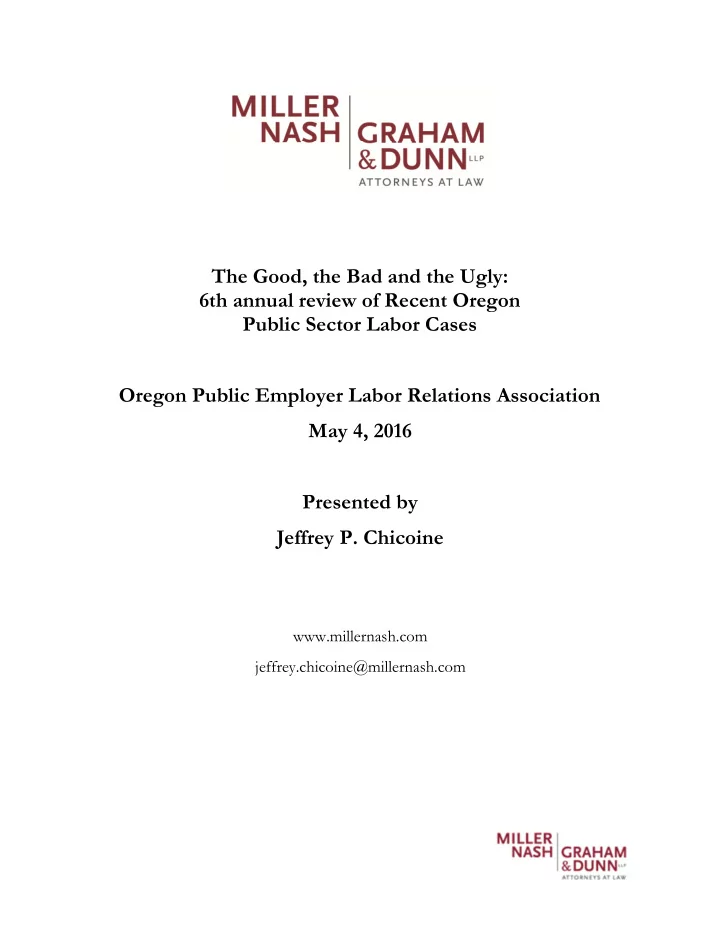

The Good, the Bad and the Ugly: 6th annual review of Recent Oregon Public Sector Labor Cases Oregon Public Employer Labor Relations Association May 4, 2016 Presented by Jeffrey P. Chicoine www.millernash.com jeffrey.chicoine@millernash.com
TABLE OF CONTENTS Page I. REPRESENTATION CASES ........................................................................................................1 A. Employee status ....................................................................................................................1 B. Fragmented unit....................................................................................................................1 II. JURISDICTION AND STANDING IN ULP CASES..............................................................2 III. INTERFERENCE & DISCRIMINATION.................................................................................3 IV. DUTY TO BARGAIN IN GOOD FAITH ................................................................................4 A. Mandatory subjects of bargaining / Unilateral change....................................................4 B. Requests for information.....................................................................................................6 C. Bad-faith bargaining: Totality of conduct ........................................................................7 V. DUTY OF FAIR REPRESENTATION.......................................................................................7 VI. HEARING PROCEDURES ...........................................................................................................8 VII. ARBITRATION.................................................................................................................................9 VIII. ERB'S PRACTICE WHEN NEITHER PARTY FILES AN OBJECTION TO A RECOMMENDED ORDER..........................................................................................................9 IX. INTEREST ARBITRATION AWARDS....................................................................................10 X. OTHER COURT CASES...............................................................................................................11 -i-
I. REPRESENTATION CASES A. Employee status 1. AFSCME v. Multnomah Cnty., No. UC-005-14, 26 PECBR 467 (May 8, 2015) The union sought to clarify the unit, directing that an administrative assistant to the county's benefit manager was not confidential and was part of the bargaining unit. ERB agreed, explaining its reasoning as follows: "Here, the record establishes that Sonne provides assistance to Daly, the current Benefits Manager. As of the hearing, Sonne had provided that assistance for about three months. Although Daly effectuates management policies with respect to employee benefits, a key aspect of collective bargaining, she does not formulate and determine management policies in this area. Specifically, Daly does not serve as a member of the County's collective bargaining team, and the record does not establish that she makes substantive decisions on what direction the County's negotiating team should take during bargaining. Rather, the evidence establishes that Daly's role is largely limited to implementing ( i.e. , effectuating) whatever benefits-related decisions are made by other County officials." Slip op at 7. 2. Hillsboro Sergeants' Ass'n v. City of Hillsboro, No. CC-009-14, 26 PECBR 491 (July 10, 2015) Petitioner sought recognition of a new bargaining unit of sergeants in the city's police department. ERB dismissed the petition, finding that the sergeants were supervisors because they had authority to assign work, applying a three-part test. Relying on the standard used by the National Labor Relations Board, ERB held that "assignment of an employee to a certain department, to a certain shift, or to certain overall tasks all generally qualify as 'assign' within our construction." Slip op at 5 (internal quotation marks and citation omitted). ERB also found that in making such an assignment, a sergeant exercises "independent judgment" and does so in the interest of management. B. Fragmented unit 3. AFSCME Council 75 v. Douglas Cnty., No. CC-004-14, 26 PECBR 354 (Feb. 4, 2015) ERB ruled that a bargaining unit of full-time and regular part-time employees in the Douglas County Assessor's Office was an appropriate unit under ORS 243.682(1)(a) and OAR 115-025-0050. The county argued that the proposed unit (1) did not have a clearly distinct community of interest required to create a bargaining unit of a portion of a group of unrepresented employees, and (2) would unduly fragment the county's workforce. ERB applied the standard community-of- interest analysis, and this case presented an interesting twist. The assessor, who is an elected official, - 1 -
had a separate set of workplace rules unique to his office that were not followed elsewhere in the county and did not follow the county rule requiring for-cause discharge. ERB gave "particularly great weight to the unique working conditions (set forth above) of the petitioned-for unit." ERB rejected the undue-fragmentation argument, noting that four units were already organized along departmental lines. ERB also declined to apply the "four-part test" from Laborers' Int'l Union of N. Am., Local 320 v. City of Keizer , No. RC-37-99, 18 PECBR 476, 483-84 (2000), stating that it was simply a listing of four factors that it considers in reviewing departmentwide petitions. ERB took the curious stance to "reject and disavow" an expansive reading of that case. In Laborers' Int'l , ERB ordered the creation of a small unit of utility workers and summarized its case law as stating that it "may conclude that a separate department bargaining unit is appropriate where: (1) employees in the proposed bargaining unit have working conditions that are significantly different from those of other personnel employed by the employer; (2) the department in which the employees work is self-contained and clearly separate from other employer operations; (3) the employees desire a separate bargaining unit; and (4) designation of the unit would not lead to undue fragmentation." 18 PECBR at 484. II. JURISDICTION AND STANDING IN ULP CASES 4. Bell v. TriMet and Bargaining Unit Pension Plan, No. UP-043-13, 26 PECBR 616 (Jan. 29, 2016), adhered to on reconsideration, 26 PECBR 660 (Mar. 8, 2016) Bell was employed as a tire service worker for TriMet when he retired. Bell was initially employed by private contractors (first Firestone and then Goodyear), which provided tire service for TriMet. In 1991, TriMet absorbed the tire service operation and staff, including Bell. Bell claimed that his TriMet pension did not correctly credit him with past service. The pension was administered by a joint union-management trust. Bell brought an unfair-labor-practice claim against TriMet and the pension plan. ERB dismissed both defendants for lack of jurisdiction: The plan was neither a public employer nor an exclusive representative, and ERB concluded that it lacked jurisdiction over the plan. Bell failed to satisfy the prerequisites for bringing a breach-of-contract claim against an employer. Bell should have filed a grievance and then, if the union failed to pursue the grievance, brought a hybrid claim for breach of the duty of fair representation against the union and breach of contract against the employer. - 2 -
Recommend
More recommend